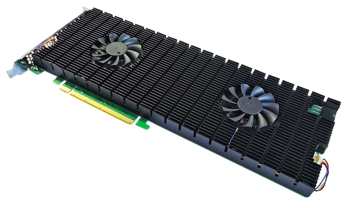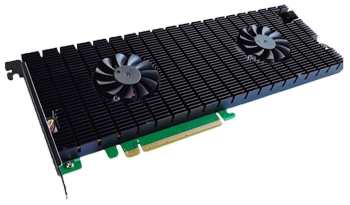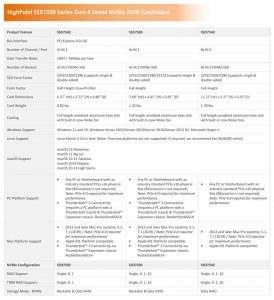HighPoint M.2 NVMe Solutions Alternative to U.2/U.3 Storage
With SSD7540 PCIe Gen4 and SSD7140A PCIe Gen3 M.2 RAID controllers, can directly host up to 8 individual M.2 SSDs.
This is a Press Release edited by StorageNewsletter.com on August 5, 2022 at 2:02 pmU.2 and U.3 NVMe SSDs are fast, reliable and available in capacities that rival SAS and SATA drives.
SSD7140a PCIe Gen3 M.2 RAID
The vast majority of U.2 and U.3 SSDs available in the marketplace are designed for enterprise class applications, and are tuned to excel in mixed-use workflows (suitable for both read and write intensive workflows), and deliver a high level of long-duration sustained write performance. On paper, this makes them for anything that needs a high-speed storage.
However, U.2 and U.3 SSDs have several noteworthy drawbacks. Enterprise features do not come cheaply; U.2/U.3 media is pricey, often several $100/TB. Secondly, they utilize the standard 2.5” drive form-factor. As a result, U.2/U.3 solutions generally require a full-sized server or rackmount chassis. This makes them less than ideal for a considerable number of data acquisition and industrial applications, all of which utilize compact or custom designed computing platforms.
Taking all of this into consideration, it’s easy to understand where the strong demand for an M.2-based solution with similar performance characteristics is coming from. But is it realistic? Can M.2 media really be used as a replacement or alternative to U.2/U.2 based storage solutions?
Case for M.2
Most M.2 SSDs are classified as client drives, and typically serve as a system’s boot volume or act as secondary storage for hosting high-performance applications. As such, they are tuned to deliver excellent random read performance and a high level of short-term or targeted write transfer speed. On the flip side of the coin, the sustained write transfer capabilities of an average M.2 SSD will degrade over time, as more and more data is transferred to the device. U.2 or U.3 media has the upper hand in this regard.
SSD7540 PCIe Gen3 M.2 RAID
While individual M.2 SSDs may not be able to match the exact performance characteristics of their U.2/U.3 counterparts, or provide as much raw storage capacity, they do provide several key and highly coveted advantages.
-
Cost-effective – The first and possibly most obvious advantage is cost. M.2 SSDs, on average, are priced 50% to 60% lower than the equivalent U.2/U.2 SSD, even when taking PCIe gen and class into consideration. The cost-effectiveness of M.2 media effectively enables administrators to plan storage configurations using a 2:1 ratio.
-
Compact form factor – The second major advantage is the small hardware footprint. It can be argued that M.2 media qualifies as the industry’s smallest mass-storage solution, and this allows for a much more compact computing platform. M.2 SSDs are hosted directly by the storage controller. U.2/U.3 SSDs, in contrast, utilize the industry standard 2.5” drive form factor, and still require a conventional server tower or rackmount chassis with dedicated drive bays.
-
Performance through storage aggregation – Though not unique to M.2 media, storage aggregation, grouping a large number of individual disks to function as a single device, is a relatively straight forward and simple task for any modern operating system. An M.2 RAID controller makes this easier.
For example, HighPoint, Inc.’ SSD7540 PCIe Gen4 and SSD7140A PCIe Gen3 M.2 RAID controllers can directly host up to 8 individual M.2 SSDs. These single-width, full-height and full length PCIe cards (about the same size as a modern video card) can be integrated into standard server and workstation platforms; no additional hardware is required. They can operate as all-in-one NVMe solutions.
-
Industry proven RAID technology: The company’s performance-focused NVMe RAID stack enables the SSD7540 and SSD7140A controllers to saturate x16 lanes of transfer bandwidth using just 4 or 5 SSDs. The additional ports allow customers to fine tune storage configurations for a variety of applications, including those normally associated with U.2/U.3 media, such as a datacenter, cloud service, or virtualization solution. A RAID-0 array comprised of 8xM.2 SSDs can maintain a baseline (minimum) 14,0000 to 16,000MB/s of sustained write performance, even when useable capacity drops to as low as 10%.
Viable alternative to U.2/U.3: M.2 RAID controllers and datacenter/NAS Class M.2 SSDs
The firm’s High Port Count 8-channel M.2 NVMe RAID controllers makes aggregating M.2 NVMe storage a simple, task. Controller installation is mostly a plug-and-play affair; all you need is a few spare minutes and a screwdriver.
The cards directly host up to 8×2242/2260/2280 M.2 SSDs, which slot in nicely beneath the removable, high-performance cooling system. You do not need to be a RAID expert to get everything up and running; drivers and management tools are readily available for all major OS platforms, and everything is installed via software wizards. Administrators of any experience level can quickly configure RAID-0, 1 or 10 arrays using a selection of tools, including a UEFI RAID utility, command line interface, and a graphical web browser-based management suite.
The company recommends pairing the SSD7540 or SSD7140A with NAS or DC class M.2 NVMe SSDs. This class of M.2 NVMe SSDs offer enterprise class features at an affordable price point. They were built for applications that must remain in operation for extended periods of time, such as an online database or cloud storage service. As such, they can consistently maintain a high level of sustained write performance over extended I/O sessions, and have long lifespans; boasting ratings in DWPD rather than TBW.
Pricing:
-
$1,099.00 for SSD7540 – PCIe Gen4 x16, 8x M.2 NVMe RAID Controller
-
$729.00 for SSD7140A – PCIe Gen3 x16, 8x M.2 NVMe RAID Controller
Resources:
SSD7540 video
SSD7140A video

















 Subscribe to our free daily newsletter
Subscribe to our free daily newsletter

